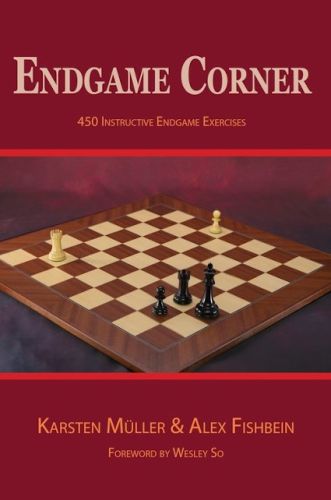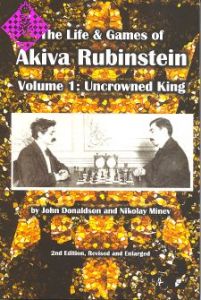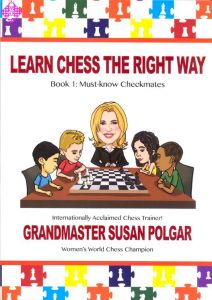Artikelnummer
LEMUEEC
Endgame Corner
450 Instructive Endgame Exercises
336 Seiten, kartoniert, Russell Enterprises, 1. Auflage 2023
There are already many endgame books, so why this one? Well, most books deal with elementary endgames, or are very advanced and contain few exercises. But you have only really learned something when you can execute it at the board, with the clock ticking. And solving exercises is very close to this scenario.
The authors present 450 endgame exercises designed to improve your understanding of endgame theory and sharpen your endgame expertise. Starting with the chapter “Specific Positions to Know,” they take you on a journey with just the right mix of practical advice and theoretical knowledge.
Endgame Corner is detailed, well-researched, informative and in-depth, with both authors sharing their experiences, recent games and new examples... I really like this material and hope that you will as well. If you are fascinated by endings, or feel the need to improve this part of your game, this book is a “must” addition to your library. – From the Foreword by Wesley So
About the Authors
German grandmaster Karsten Müller hosts the popular ChessBase series Endgame Magic, and American grandmaster Alex Fishbein writes an endgame column for the American Chess Magazine.
The authors present 450 endgame exercises designed to improve your understanding of endgame theory and sharpen your endgame expertise. Starting with the chapter “Specific Positions to Know,” they take you on a journey with just the right mix of practical advice and theoretical knowledge.
Endgame Corner is detailed, well-researched, informative and in-depth, with both authors sharing their experiences, recent games and new examples... I really like this material and hope that you will as well. If you are fascinated by endings, or feel the need to improve this part of your game, this book is a “must” addition to your library. – From the Foreword by Wesley So
About the Authors
German grandmaster Karsten Müller hosts the popular ChessBase series Endgame Magic, and American grandmaster Alex Fishbein writes an endgame column for the American Chess Magazine.
| EAN | 9781949859850 |
|---|---|
| Gewicht | 480 g |
| Hersteller | Russell Enterprises |
| Breite | 15 cm |
| Höhe | 22,7 cm |
| Medium | Buch |
| Erscheinungsjahr | 2023 |
| Autor | Karsten MüllerAlex Fishbein |
| Sprache | Englisch |
| Auflage | 1 |
| ISBN-13 | 978-1-949859-85-0 |
| Seiten | 336 |
| Einband | kartoniert |
| Name | Russell Enterprises |
|---|---|
| Adresse | 234 Depot Road Milford, CT 06460 USA |
| Internet | www.Russell-Enterprises.com |
| hwr@russell-enterprises.com |
Verantwortlicher Importeuer:
| Name | Schachversand Niggemann |
|---|---|
| Adresse | Schadowstraße 5 48163 Münster Deutschland |
| info@schachversand.de | |
| Internet | www.schachversand.de |
Beautiful and challenging yet bruising to the ego.
Endgame Corner is an exercise workbook, but also something more. There are 450 exercises in total, in a salubrious layout of 6 diagrams a page, with very full solutions following soon after. Each diagram has one or more asterisks (up to five), according to how difficult it is. Five is the most difficult. You are also told whether it is white or black to move. Nothing else.
Here is what you get in detail, chapter by chapter.
The first chapter deals with what the authors call ‘specific positions’, so a mix. These are key theoretical positions, sometimes involving exceptions of various sorts (for example, king and rook versus king and bishop where the side with the rook can force a win) and situations where (quite surprisingly, in some cases) extreme precision is needed, either to triumph or to hold the draw. 25 positions are given.
Four times as many positions (that is, 100) are given in the next chapter, which is devoted to pawn endings. The authors explain that they include here also positions where a queen battles against a pawn or pawns (you can think of this as a pawn ending where one side has just promoted first), but in fact only one position of this type is included.
Chapter 3 is concerned with the ‘transition to a pawn ending’ and consists of 20 positions. Here you need to decide whether it is best to trade pieces and go into a pawn ending or not, as the case may be. Also, there are some positions where you can make a desirable move but one which would allow an exchange of pieces. Do you want to give your opponent this possibility? Clearly, evaluation is as important as calculation in these cases.
Rook endings make up the fourth and largest chapter. Hardly surprising, perhaps, since they occur most frequently in practice. Anyway, there are a whopping 150 positions; and a great majority are in the difficult or very difficult category, which was good to hear!
Opposite-coloured bishops are the subject of chapter 5. Received wisdom has it that these endings are generally dull and drawish, but that’s not the case here. These positions are full of nuance.
The next three chapters are concerned with material imbalance in some form. In chapter 6 we see 24 scenarios where a minor piece is battling against pawns, where the the side with the greater material advantage is playing to draw almost always. Chess is paradoxical game. Chapter 7 (28 positions) sees the old adversaries, bishop and knight, duelling. They have the same nominal value, of course, but very different qualities, and the jury is still out, the verdict not yet in, on which piece is the most prized.
Chapter 8 has 20 positions which feature rook versus minor piece.
Finally, we come to chapter 9, which has 60 ‘mixed’ exercises. These are complicated positions where a very concrete approach required and the solutions are very often ‘study-like’. A case in point is the zugzwang in position 9-60, arising from a continuation missed by both Magnus Carlsen and Maxime Vachier-Lagrave, being a case in point.
What to say in addition? Well, all these positions are taken from actual play but a lot of them as exercises are so difficult that the players themselves (usually strong grandmasters, often world class players like Carlsen and MVL) went awry. Because the ideas are well hidden: tricky, surprising, deceptive. Of course the players had to contend with competitive conditions and may well have been tired or short of time. Also, unlike we the readers, they did not know that there was a solution to be found (not that such foreknowledge always makes solving an exercise any easier…).
This is a very practical book, as shown by its emphasis on rook endings, the most commonly occurring in practice, and pawn endings, which are as foundational to chess as putting is to golf, as Purdy once put it. The authors refer to their book as an ‘endgame proving ground’, which I found a fascinating notion. They provide a way to test and apply your knowledge, to monitor and diagnose your understanding, and perhaps it’s most valuable feature is this: it will tell you what you do not know. In this, their solutions, replete with explanations and analysis, provide invaluable food for thought.
Solving exercises is an enjoyable form of active learning and the authors recommend what has come to be known as ‘the woodpecker method’, after the book of that name, which means that you should solve the same exercises again after a period of a month, two months, four months, etc. to reinforce learning. I’d add that, in my experience, there are always one or two niggly positions that you don’t quite get.
Endgame Corner is a book that is challenging, full of beautiful, and elegant play, and (let me be frank) at times bruising to the ego!
Paul Kane
https://thecaissakid.wordpress.com/2024/06/13/endgame-corner/
Endgame Corner is an exercise workbook, but also something more. There are 450 exercises in total, in a salubrious layout of 6 diagrams a page, with very full solutions following soon after. Each diagram has one or more asterisks (up to five), according to how difficult it is. Five is the most difficult. You are also told whether it is white or black to move. Nothing else.
Here is what you get in detail, chapter by chapter.
The first chapter deals with what the authors call ‘specific positions’, so a mix. These are key theoretical positions, sometimes involving exceptions of various sorts (for example, king and rook versus king and bishop where the side with the rook can force a win) and situations where (quite surprisingly, in some cases) extreme precision is needed, either to triumph or to hold the draw. 25 positions are given.
Four times as many positions (that is, 100) are given in the next chapter, which is devoted to pawn endings. The authors explain that they include here also positions where a queen battles against a pawn or pawns (you can think of this as a pawn ending where one side has just promoted first), but in fact only one position of this type is included.
Chapter 3 is concerned with the ‘transition to a pawn ending’ and consists of 20 positions. Here you need to decide whether it is best to trade pieces and go into a pawn ending or not, as the case may be. Also, there are some positions where you can make a desirable move but one which would allow an exchange of pieces. Do you want to give your opponent this possibility? Clearly, evaluation is as important as calculation in these cases.
Rook endings make up the fourth and largest chapter. Hardly surprising, perhaps, since they occur most frequently in practice. Anyway, there are a whopping 150 positions; and a great majority are in the difficult or very difficult category, which was good to hear!
Opposite-coloured bishops are the subject of chapter 5. Received wisdom has it that these endings are generally dull and drawish, but that’s not the case here. These positions are full of nuance.
The next three chapters are concerned with material imbalance in some form. In chapter 6 we see 24 scenarios where a minor piece is battling against pawns, where the the side with the greater material advantage is playing to draw almost always. Chess is paradoxical game. Chapter 7 (28 positions) sees the old adversaries, bishop and knight, duelling. They have the same nominal value, of course, but very different qualities, and the jury is still out, the verdict not yet in, on which piece is the most prized.
Chapter 8 has 20 positions which feature rook versus minor piece.
Finally, we come to chapter 9, which has 60 ‘mixed’ exercises. These are complicated positions where a very concrete approach required and the solutions are very often ‘study-like’. A case in point is the zugzwang in position 9-60, arising from a continuation missed by both Magnus Carlsen and Maxime Vachier-Lagrave, being a case in point.
What to say in addition? Well, all these positions are taken from actual play but a lot of them as exercises are so difficult that the players themselves (usually strong grandmasters, often world class players like Carlsen and MVL) went awry. Because the ideas are well hidden: tricky, surprising, deceptive. Of course the players had to contend with competitive conditions and may well have been tired or short of time. Also, unlike we the readers, they did not know that there was a solution to be found (not that such foreknowledge always makes solving an exercise any easier…).
This is a very practical book, as shown by its emphasis on rook endings, the most commonly occurring in practice, and pawn endings, which are as foundational to chess as putting is to golf, as Purdy once put it. The authors refer to their book as an ‘endgame proving ground’, which I found a fascinating notion. They provide a way to test and apply your knowledge, to monitor and diagnose your understanding, and perhaps it’s most valuable feature is this: it will tell you what you do not know. In this, their solutions, replete with explanations and analysis, provide invaluable food for thought.
Solving exercises is an enjoyable form of active learning and the authors recommend what has come to be known as ‘the woodpecker method’, after the book of that name, which means that you should solve the same exercises again after a period of a month, two months, four months, etc. to reinforce learning. I’d add that, in my experience, there are always one or two niggly positions that you don’t quite get.
Endgame Corner is a book that is challenging, full of beautiful, and elegant play, and (let me be frank) at times bruising to the ego!
Paul Kane
https://thecaissakid.wordpress.com/2024/06/13/endgame-corner/
Mehr von Russell Enterprises
-
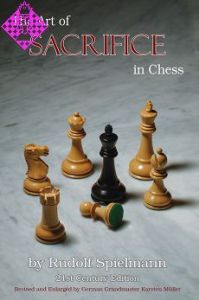 The Art of Sacrifice in Chess24,95 €
The Art of Sacrifice in Chess24,95 € -
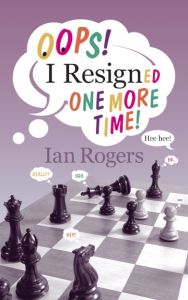 Oops! I Resigned One More Time!19,95 €
Oops! I Resigned One More Time!19,95 € -
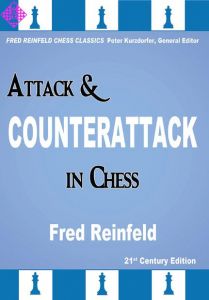 Attack & Counterattack in Chess12,95 €
Attack & Counterattack in Chess12,95 € -
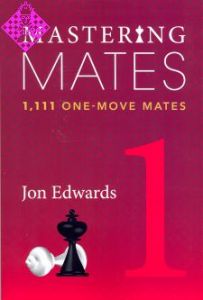 Mastering Mates 17,95 €
Mastering Mates 17,95 € -
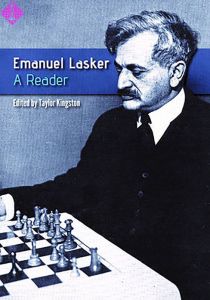 Emanuel Lasker: A Reader34,50 €
Emanuel Lasker: A Reader34,50 € - Mehr von Russell Enterprises

